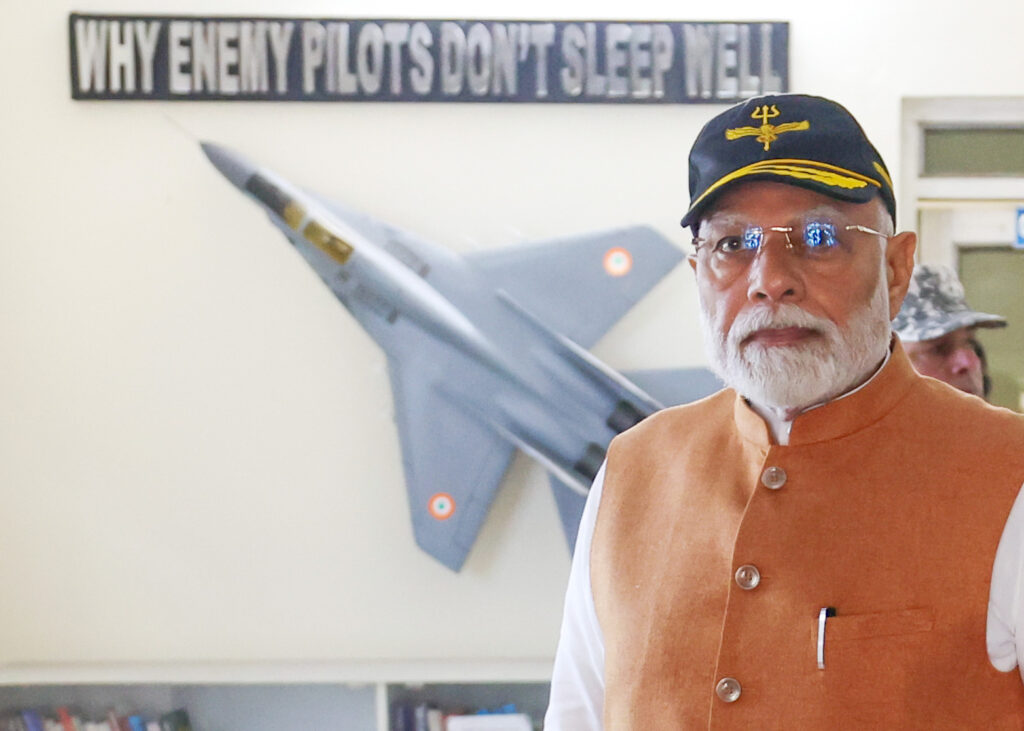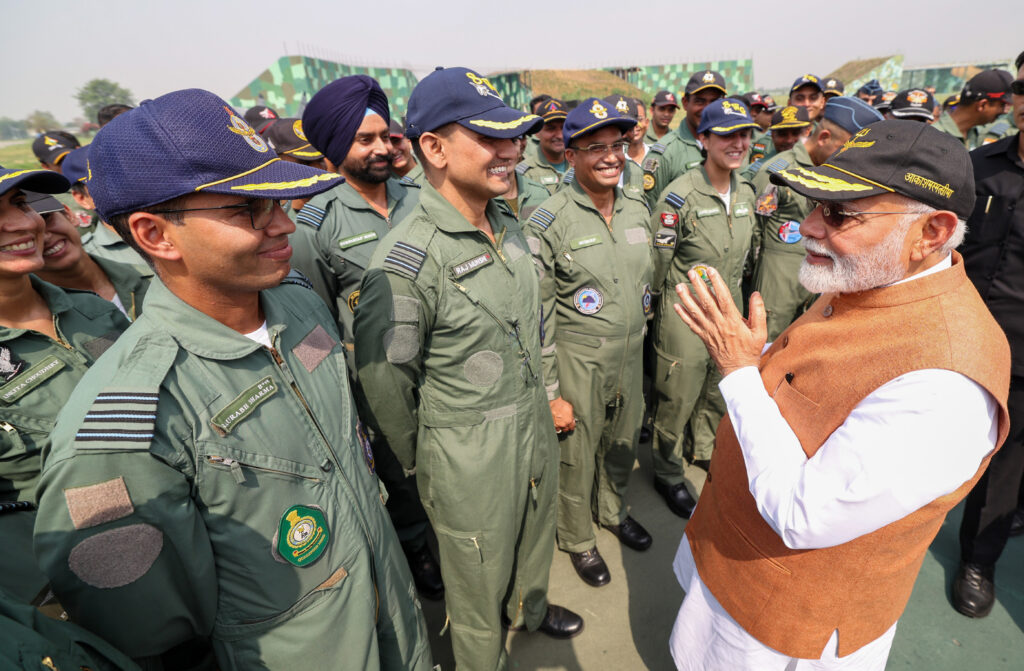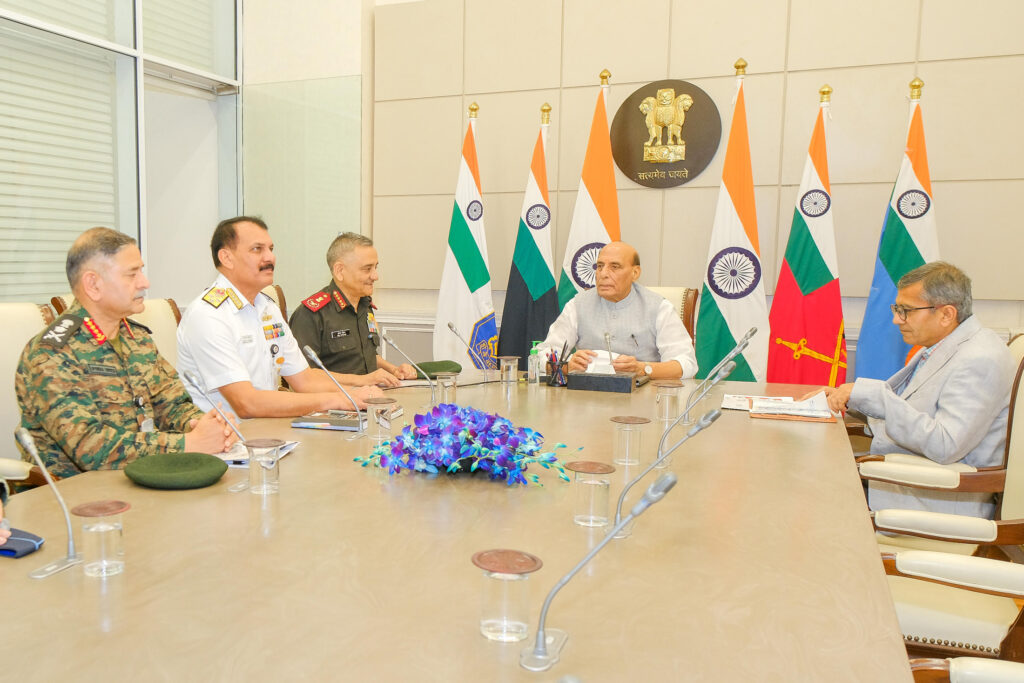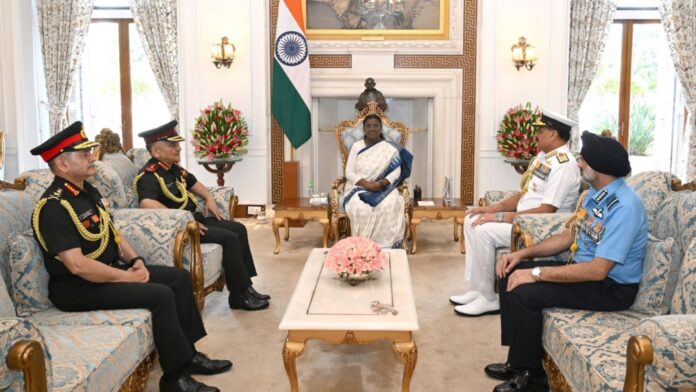By Chaitali Bag
The face of national security has been transforming rapidly, and India stands at the very forefront of this change. Operation SINDOOR—a name already etched into the annals of our contemporary military history—marked a resounding affirmation of how technological self-reliance, or Aatmanirbhar Bharat, has become India’s strongest shield and sharpest spear. This is the story of how indigenous innovation is not just a buzzword, but a battle-hardened reality taking center stage in securing our nation.
A Calculated, Proud Response to Changing Threats
The tragic terrorist attack on tourists in Pahalgam in April 2025 was a grim reminder that the nature of modern conflict is unpredictable and often insidious. The enemy does not always wear a uniform, and civilian lives are increasingly at risk. India’s response through Operation SINDOOR, however, was anything but reactive or unsophisticated. It was a display of strategic brilliance, one that balanced firmness with restraint. Without venturing across the Line of Control or breaching international boundaries, Indian forces managed to dismantle key elements of terrorist infrastructure and neutralize multiple threats.
But the true revelation of the operation was not only in the precision of its execution—it was also in the technology that made it possible. For the first time at such a scale, indigenous high-tech solutions became the backbone of a large-scale military operation, proving that India’s ambition to be Aatmanirbhar is not just aspirational, but actionable.

India Triumphs! PM Modi Hails Operation Sindoor’s Historic Victory
In a rousing and impassioned address to the nation, Prime Minister Shri Narendra Modi conveyed a message brimming with pride, resilience, and the unwavering determination of a new, confident India! Speaking via videoconference, he resoundingly celebrated the historic success of Operation Sindoor, expressing heartfelt gratitude to the country’s indefatigable armed forces, astute intelligence agencies, and visionary scientists, whose collective dedication has elevated the country’s stature on the global stage. With stirring words, he saluted the valor and fierce courage of Indian soldiers, whose heroic actions during the operation not only achieved their objectives but also set a gold standard for bravery, resilience, and patriotism. The Prime Minister dedicated this monumental achievement to every mother, sister, and daughter of the nation, underscoring the operation’s deep emotional resonance with the people of India. Strongly condemning the barbaric terrorist attack in Pahalgam, which sent shockwaves throughout the country and the world, Shri Modi gave voice to the nation’s united and deep anguish, lambasting the heinous attempt to fracture India’s social fabric. He declared, with robust clarity, that the government stands unwaveringly united in its mission to eradicate terrorism, having empowered our military with the full freedom to strike at the roots of terror. The extraordinary precision and courage of the Indian armed forces during Operation Sindoor, striking at terrorist dens deep inside Pakistan, sent a clear and powerful message: India will no longer tolerate any threat to its people, especially its women, and will respond with unapologetic might and resolve. The Prime Minister triumphantly recounted how Indian missiles and drones obliterated notorious terror hubs like Bahawalpur and Muridke—the epicenters of decades of global terrorism and masterminds of atrocities across continents. By eliminating more than a hundred of the world’s most dangerous terrorists, including those who had targeted India for decades, India has not only delivered justice but also shattered the morale of terror organizations and their sponsors. As Pakistan floundered in frustration, lashing out with reckless attacks on schools, temples, and civilian sites, India’s sophisticated air defense neutralized their attempted aggression, turning the tables and quickly establishing clear dominance. Within days, the overwhelming Indian response compelled Pakistan to seek de-escalation, with its military pledging a halt to terrorism and cross-border violence—testament to the devastating impact of India’s resolve. Yet, as Prime Minister Modi made clear, this new era of security is not about resting on laurels: India’s armed forces remain vigilantly watchful, ready to adapt and counter any future threats. Operation Sindoor, he announced, is now a byword for the nation’s establishment of a new, firm doctrine rooted in three unshakeable pillars—Decisive Retaliation, No Tolerance for Nuclear Blackmail, and No Distinction Between Terrorists and Their State Sponsors. With clarity and conviction, he exposed Pakistan’s duplicity and state complicity in terror, reiterating that India will act decisively wherever its people are threatened. Rejoicing in India’s prowess—from deserts to mountains, and now in the cutting-edge realm of New Age warfare—he proudly proclaimed the world’s recognition of “Made in India” defence excellence, which powered this victory. Above all, Prime Minister Modi energized the spirit of unity, declaring that only Zero Tolerance for terrorism will guarantee a safer, brighter world. In closing, he delivered an uncompromising warning: for Pakistan, the only path to survival is to dismantle terror at its root—no more double speak, no more trade-offs with terror. The world, he said, must know that for India, the only topics on the table are the defeat of terrorism and the return of Pakistan-Occupied Kashmir. With hope, grit, and the unyielding power of a united people, Shri Modi ushered in a bold new chapter for India, one where the dignity, safety, and strength of every Indian are paramount!

Air Defence: When Technology Takes the Lead
The massive, coordinated attack attempt by Pakistan in May 2025, using drones and missiles to target strategic locations across Northern and Western India, could have been catastrophic. But the performance of India’s Integrated Counter UAS Grid and Air Defence (AD) systems turned the tide. The combined assets of the Army, Navy, and especially the Air Force worked in perfect sync, deploying a dazzling array of indigenous and legacy systems. The outcome? An impenetrable wall—no less.
Among these, the indigenously developed Akash missile system emerged as the hero of the hour. The Akash system, designed and produced in India, showcased its capability to counter multiple threats seamlessly, its ECCM features thwarting enemy jamming efforts, and its mobility bringing agility to air defence. The legacy systems, such as Pechora and OSA-AK, stood proudly alongside the new, exemplifying the perfect marriage of imported experience and domestic innovation.
And above all, the Integrated Air Command and Control System (IACCS) fused these varied elements into a single, harmonious network—a textbook demonstration of net-centric warfare, wholly made-in-India.
Offensive Precision, Indigenous Power
Operation SINDOOR was not just about protecting home soil; it was also about sending a clear, precise message. India’s offensive strikes targeted critical enemy airbases with impressive precision. The use of loitering munitions, or kamikaze drones—domestically developed and refined—illustrated how India’s defence sector has quietly leapfrogged into the big league. These systems hovered patiently, then struck with devastating accuracy, taking out high-value assets such as radars and missile batteries.
Even more stunning was the Indian Air Force’s ability to bypass and jam advanced, Chinese-supplied air defence systems in Pakistan, once thought to be nearly impenetrable. The entire operation, completed in a mere 23 minutes, not only eliminated the intended targets but did so without incurring any losses, a tribute to the superior planning and world-class indigenous support systems in surveillance, intelligence, and weapon delivery.
Evidence of Neutralized Threats: Testament to India’s Rising Techno-Defence Prowess
Operation SINDOOR marked a significant milestone—both in India’s ongoing battle against cross-border militancy and in its emergence as a powerhouse in indigenous defence technology. Recent revelations from the operation have presented concrete, compelling evidence of hostile technologies that were not just outsmarted but actively neutralized by Indian systems. Among these were fragments of PL-15 missiles (supplied by China), wreckage of Turkish-origin UAVs known, perhaps playfully, as “Yiha” or “YEEHAW”, and various long-range rockets, quadcopters, and commercial drones. Their recovery speaks volumes: even as adversaries like Pakistan introduced advanced, foreign-supplied weaponry onto the battlefield, India’s homegrown air defence and electronic warfare solutions stood unflinching and superior.

India Strengthens Security with Indigenous Defence Technologies
India’s spectacular success in Operation Sindoor stands as a glowing tribute to the nation’s relentless pursuit of self-reliance in defence technology. Fuelled by the ‘Atmanirbhar Bharat’ vision, Indian scientists, engineers, and defence personnel have forged a robust and modern arsenal—crafted not just for deterrence, but to deliver decisive superiority on the battlefield!
At the forefront was Akashteer, the Indian Army’s new digital brainchild, developed by Bharat Electronics Limited. Acting as a real-time, networked command center, Akashteer wove together radar feeds from across the border and skies, transforming scattered data into a comprehensive, live operational picture. Its unmatched capability to detect, track, and automate the destruction of aerial intruders allowed India’s defenders to counter every missile and drone unleashed by the adversary, proving its worth as the new linchpin of low-level air defence.
Shoulder to shoulder with Akashteer, the Akash Missile System showcased the power of indigenous engineering. Born out of the DRDO and assembled with pride by Bharat Dynamics, the Akash missile hit the sweet spot of versatility and reliability. Whether intercepting enemy jets, incoming cruise missiles, or swarms of hostile drones, Akash’s mobile launchers and Rajendra radar system delivered target-neutralising precision again and again. For the visionaries like Dr. Prahlada Ramarao and Dr. APJ Abdul Kalam, witnessing Akash in action was the realization of a dream decades in the making—a truly Indian shield, forged by Indian hands!
But India’s technological marvels didn’t stop there. The DRDO’s D-4 Anti-Drone System brought a new dimension to asymmetrical warfare, swatting down enemy drones with a blend of radar acuity and cutting-edge jamming technology. And then came the thunderous debut of BrahMos—the world’s fastest supersonic cruise missile. On May 10, 2025, BrahMos swooped into history with surgical strikes on high-value Pakistani military sites, overwhelming enemy defences and rewriting the rules of engagement.
The homegrown arsenal expanded further with innovations like the Nagastra-1 loitering munition, the SkyStriker, and the L-70 anti-aircraft gun—each testimony to the ingenuity and versatility of India’s defence ecosystem. The powerful Pinaka rocket launcher and medium-range surface-to-air missiles, built with Israeli collaboration, fortified India’s arsenal, leaving no blind spot in its layered defence network.
From early warnings to pinpoint strikes, from jamming swarms to launching surges of guided missiles, India’s indigenous systems are no longer mere dreams—they are operational realities, tested and triumphant. Operation Sindoor was not just a military victory; it was a celebration of Indian innovation, unity, and self-belief. Full throttle, unstoppable—India’s technological backbone has redefined the future of national defence!
India’s Multi-Layered Air Defence: Synchronicity in Action
On May 12, Lt Gen Rajiv Ghai, DGMO, outlined the exemplary performance of India’s defence network during a pivotal press briefing. What stood out was not just the firepower, but the perfectly orchestrated harmony of legacy and state-of-the-art systems. Knowing that precise anti-terror strikes within Indian territory would likely provoke a cross-border response, the Indian Army activated a unique fusion of Counter Unmanned Aerial Systems (CUAS), electronic warfare assets, and robust air defence weaponry from both the Army and Air Force.
Multiple defensive layers—stretching inland from the International Boundary—formed an impenetrable shield: CUAS tackled low-flying threats, shoulder-fired weapons provided agile close defence, and a blend of legacy and new-generation air defence weapons wove together a blanket of security. This synergy effectively thwarted the Pakistan Air Force’s retaliation attempts on Indian airfields and logistic hubs during the night of May 9–10, ensuring civilian and military infrastructure escaped harm. The triumph was unmistakable: years of relentless government investment in layered, modern defence paid off handsomely, transforming these systems into force multipliers during one of the nation’s most critical operations.

ISRO: Watching from the Skies
No account of India’s security net is complete without recognizing the indomitable spirit of its space program. ISRO takes vigilance to new heights—literally. On May 11, ISRO Chairman V Narayanan revealed that at least ten satellites are ceaselessly monitoring the nation’s boundaries, from the 7,000 km coastline to the vast, sensitive northern frontiers. Satellites and drone technology aren’t just tools; they are sentinels, providing advance warnings and precision intelligence, without which national security would be unattainable.
The Unstoppable Rise of India’s Drone Industry
At the heart of India’s techno-defence transformation is its booming domestic drone industry. The Drone Federation of India (DFI) stands as a beacon of innovation, uniting over 550 companies and 5,500 drone pilots. Its vision—to make India the global drone hub by 2030—is rapidly materializing. Indian firms are designing, developing, and exporting cutting-edge drones and counter-drone technology, supporting both defence and civilian and industrial applications.
Industry leaders like Alpha Design Technologies, Tata Advanced Systems, Paras Defence & Space Technologies, and IG Drones have emerged as trailblazers. Whether through joint ventures with global giants or homegrown R&D excellence, these companies are putting India on the global map, fostering self-reliance while feeding into a secure, technology-led future.
Drones at the Centre of Modern Warfare: India’s Leap into the Future
Across the globe, the face of modern warfare is changing, and at the heart of this transformation are drones. Once the preserve of a handful of technologically advanced nations, unmanned aerial vehicles (UAVs) are now at the core of how wars are fought, won, and deterred. Nowhere is this more evident than in India, a country that has taken immense strides in integrating drone technology into its military doctrine, championing an exciting era of indigenization and innovation.
The seeds for India’s drone revolution were sown well before the world’s eyes turned to swarming quadcopters on distant battlefields. Years of strategic investment in domestic research and development, and a sweeping policy overhaul—spearheaded by the vision of self-reliance—have set India apart. The government’s 2021 decision to ban imported drones and launch the Production Linked Incentive (PLI) scheme was a masterstroke, turbocharging indigenous manufacturing and encouraging homegrown startups and established defence firms alike. With Rs 120 crores in incentives over three years, the Ministry of Civil Aviation charted a course for rapid home-grown innovation, setting the stage for India’s ascendancy in drone warfare.
But drones are only the tip of the technological iceberg. India’s defence manufacturing prowess, driven relentlessly by the “Make in India” initiative, has fostered an ecosystem where advanced artillery, aircraft, and naval platforms are rolling off the assembly lines with increasing regularity. The numbers tell a stirring story: indigenous defence production soared to ₹1.27 lakh crore in FY 2023–24, with exports surging an astonishing 34-fold since 2013–14. From the LCA Tejas jets slicing through the skies, to formidable MBT Arjun tanks and the agile Light Combat Helicopter Prachand, Indian-made platforms are now the backbone of the nation’s military.
The vision doesn’t end at home. With defence exports smashing records at nearly Rs 24,000 crore in FY 2024–25—and with targets set at a staggering Rs 50,000 crore by 2029—India is advancing with confidence towards becoming the world’s largest defence exporter by 2047. Strategic reforms, groundbreaking public-private partnerships, and robust government backing, through initiatives like iDEX and the SRIJAN drive, and dual Defence Industrial Corridors, have supercharged this progress.
One of the brightest beacons in this sea of innovation is the next generation of drones—autonomous, AI-powered, and connected. The groundwork for integrating artificial intelligence into military drones is well underway, promising a future where decision-making is faster, smarter, and more reliable. These advances will allow India’s armed forces to operate in highly complex environments with unprecedented precision.
The true test of these initiatives, though, comes not just in statistics or projections, but on the battlefield. Operation SINDOOR is a ringing testament to the power of Indian innovation. In the heat of conflict, Indian-made drones, air defence systems, and cutting-edge electronic warfare platforms proved their mettle, vindicating years of investment and policy reform. The successful deployment of indigenous technologies isn’t just about tactical victories. It is a validation of India’s vision, underscoring its ability to defend its people, safeguard its sovereignty, and export security solutions to the world.
Drones have emerged as the flagbearers of a new era in Indian defence, poised at the very centre of modern warfare. The fusion of public ambition, private ingenuity, and strategic resolve means that India not only dreams of self-reliance but is rapidly achieving it. The battlefield of tomorrow will be driven by technology, agility, and innovation, and as Operation SINDOOR has shown, India is more than ready. Armed with its inventions, steeled by visionary policies, and powered by the creative energy of its people, India stands at the frontier of military modernization—confident, capable, and determined to shape the wars of the future.

India’s Ascent—Assurance through Innovation
The lessons from Operation SINDOOR are resounding and optimistic. Not only did India demonstrate the ability to neutralize the world’s most advanced hostile technologies, but it also displayed the breadth and depth of its integrated, multi-layered air defence. With the vigilant gaze of ISRO’s satellites and the ingenuity of a thriving drone industry, India’s resolve to defend its sovereignty is empowered by innovation, expertise, and steely determination.
Operation SINDOOR is more than a chapter in modern military history; it’s a clarion call affirming that India’s defence ecosystem is robust, resilient, and ready for every challenge—a beacon for the future, fuelled by indigenous pride and scientific prowess. The message is clear: India not only meets threats head-on but neutralizes them with world-class precision and unbreakable confidence.
A New Dawn in Defence: Aatmanirbhar Bharat in Action
Operation SINDOOR is not just a military success; it is a clarion call for the nation. It showcases the spectacular rise of home-grown innovation in the field of national security and proves that “Made in India” is more than a patriotic slogan—it is a war-winning advantage. From advanced missile systems to integrated command platforms, from kamikaze drones to electronic warfare, India’s defence establishment is now defined by self-reliance as much as by courage.
Operation SINDOOR is our victory—but more than that, it is our promise: that Aatmanirbhar Bharat will always rise to protect, deter, and triumph.


